15 Surprising Human Trafficking Hotspots in the U.S.
Human trafficking hot spots look different for sex trafficking, labor trafficking, and instances that have both commercial sex and forced labor elements. Let’s take a look at what 15 of these human trafficking hot spots look like.

The United States is one of the worst countries in the world for human trafficking. Experts estimate that there are over 199,000 incidents of human trafficking happening annually. To make matters worse, the number of reported cases is much smaller.
The National Human Trafficking Hotline started collecting data on human trafficking cases from December 2007 through December 2016. Polaris’s BeFree Text line collected data from March 2013 to December 2016.
Between these two sources, they identified 32,208 human trafficking cases. 65% of cases can fall into into different “types” of trafficking, allowing us to determine human trafficking hotspots. They also identified 10,085 cases of labor trafficking, 60% of which are classifiable.
It’s important to note that there are limitations when collecting information about human trafficking. The information comes from reports and tips made by the public. This means that the statistics in this blog post don’t come from a random sample. There are no structured interviews to ask victims and survivors about their demographics and experiences.
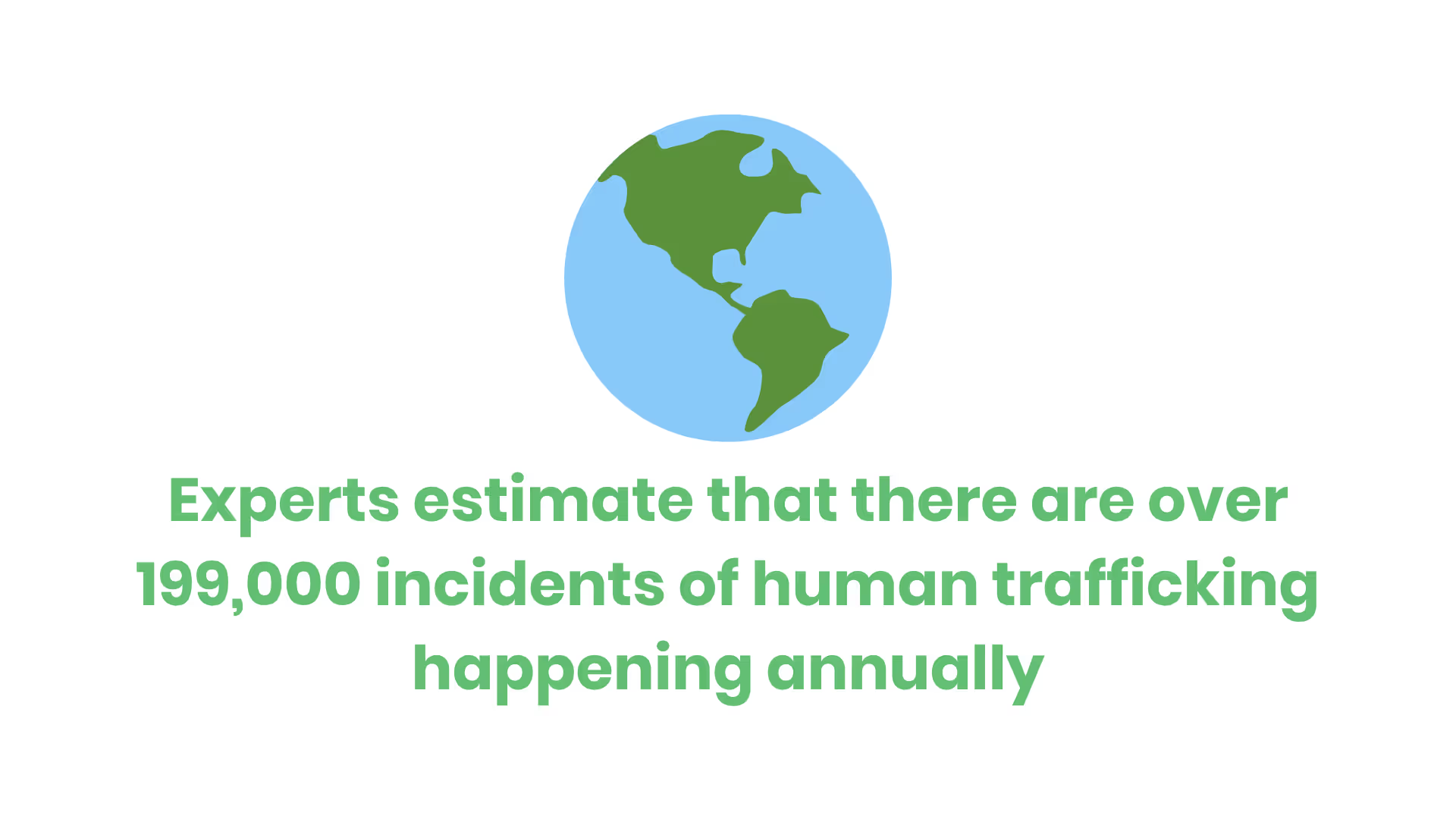
We must also consider who has access to hotline numbers. Not many people know what human trafficking looks like and even if they do, they may not make a phone call or send a text. The general awareness about certain types of trafficking needs improvement. Additionally, not every victim has the means to self-identify and reach out for help.
That said, it’s clear that there are many human trafficking hot spots based on the numbers available. Certain industries and venues are more prone to human trafficking because it’s easy to exploit and conceal victims while keeping them under control.
What do these hotspots look like?
Human trafficking hot spots look different for sex trafficking, labor trafficking, and instances that have both commercial sex and forced labor elements. Let’s take a look at what 15 of these human trafficking hot spots look like.
Sex Trafficking
Sex trafficking is the most common form of human trafficking. Unfortunately, it’s difficult for people in the anti-trafficking field to identify and disrupt human trafficking networks in the U.S.
Individuals combating human trafficking confront many challenges. One of the most significant challenges is the lack of data that shows how human trafficking happens in the real world.
Luckily, there’s more data today than in the past because of tips coming into the hotline and a growing number of arrests, prosecutions, and convictions.
In 2021, sex trafficking cases accounted for 92% of new federal human trafficking prosecutions. There were 129 new criminal sex trafficking cases, 29 of which had adult victims and 73 with only child victims. There were 570 active criminal sex trafficking cases ongoing in the court system as well.
These cases revealed some major human trafficking hotspots. Let’s take a look at what these hot spots look like, the pervasiveness of these industries and venues, and victim demographics.
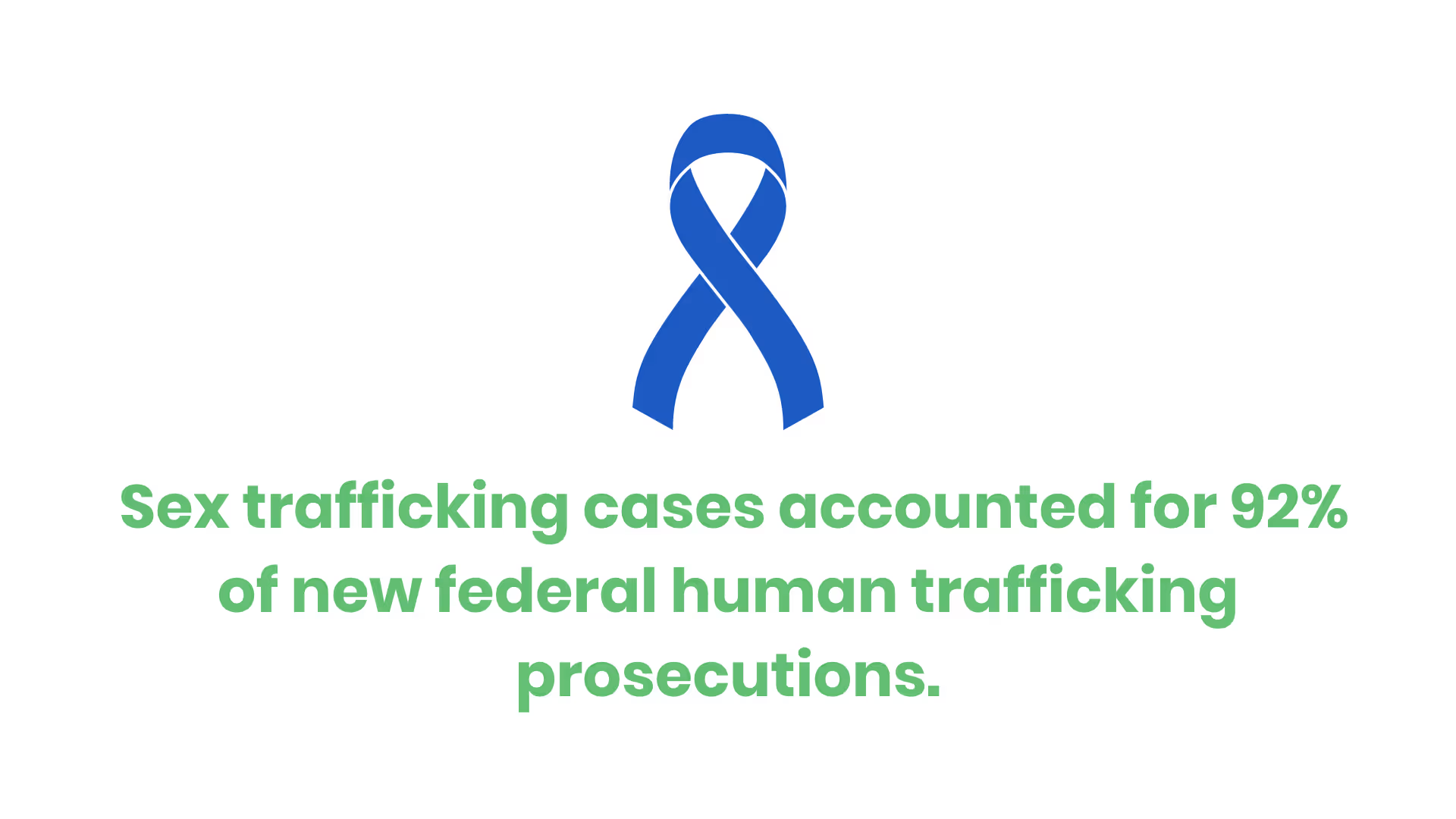
Pornography
Pornography is a major hot spot in the world of human trafficking. Out of 16,951 known human trafficking cases between 2007 and 2016, 616 of them fall under the category of pornography. In 2021, there were 807 newly identified human trafficking situations involving pornography. 4 cases involved both sex trafficking and labor trafficking.
The National Human Trafficking Hotline documented cases of family members, intimate partners, and individual traffickers earning profits from distributing pornography. They obtain the images from a victim non-consensually.
It’s important to note that trafficking involving webcams doesn’t fall under the category of pornography. This is actually a form of remote interactive sexual activity, which is its own separate category.

When talking about pornography, we’re referring to the pre-recording of sexually explicit videos and images. These images may feature adults, adolescents and even minors. It can also involve commercial sex acts through a formal pornography company. This means that human trafficking in pornography happens in both informal and formal settings.
What do victims of pornographic trafficking look like?
Unfortunately, there’s limited data on these types of victims. The data that does exist shows that of the 616 cases with usable data, survivors are typically female. 490 victims, or 80%, are female. 16% of known victims, or 97 individuals are male. That said, the rate of male victimization is four times the rate that that of other sex trafficking hot spots.
61% of known victims are minors. This translates to 377 adolescents. Another 42% or 260 individuals are adults. We don’t know the age of the remaining percentage of victims.
We do know that at least 223 victims, or 36% of them, are U.S. citizens and another 78 (13%) are foreign nationals. Because much of the data on citizenship is not available, the percentages are very small.
Residence-Based Commercial Sex
The label “residential” includes sex trafficking happening within residential brothels or private households. Between 2007 to 2016, there were 1,290 residential sex trafficking cases. In 2021, there were 525 cases.
Residential brothels are often run by a network of coordinated traffickers with a more formalized business model. These tend to cater to commercial sex buyers from similar ethnic and/or language backgrounds. The traffickers advertise the residential brothel through word of mouth or covert business cards.
Human sex trafficking in private households happens in non-commercial residential locations. These types of venues are more informal than residential brothels. Advertisements for this type of model vary but often include word of mouth and websites like Backpage.com.
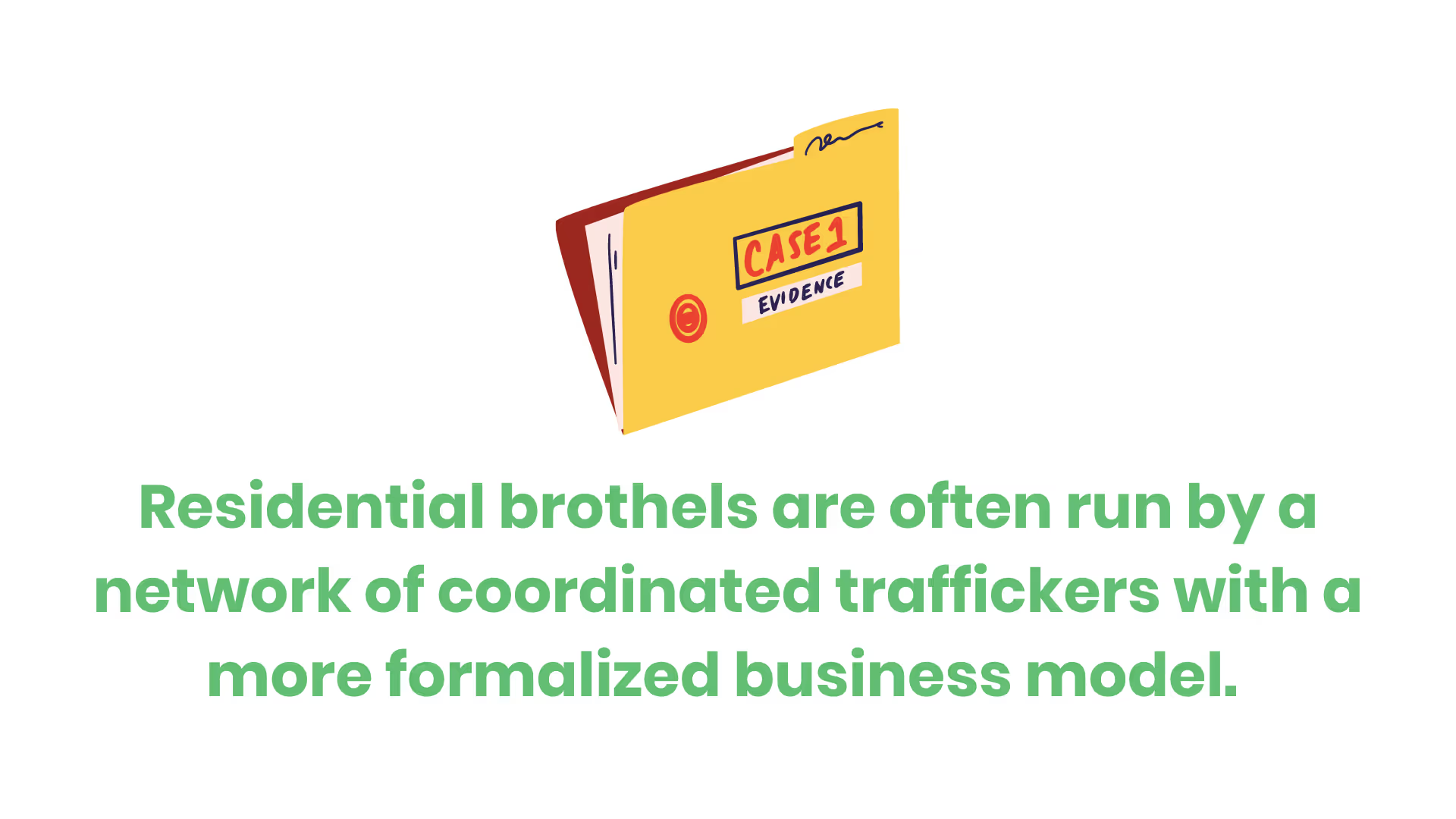
The vast majority of residence-based trafficking victims are female. 1219 victims, or 94% of them, were female while another 99 victims were male. In more formalized brothels, victims tend to be adult women and maybe some adolescent girls.
Many of these victims are from Latin America, particularly Mexico, and From Southeast Asia, particularly China. That said, about 304 victims, or 24% of them, are foreign nationals. Another 432 victims, 33% of them, are U.S. citizens. We simply don't have information on the rest of identified victims.
Traffickers control victims in formal settings through the use of physical violence, lethal threats to victims and their families, debt bondage, and extreme confinement and monitoring.
Informal residence-based victims are typically children, with boys making up a growing percentage. Traffickers often control these victims through the use of confinement, inducing illicit substances, threats to harm or expose, and exploiting familial or intimate relationships. The use of force, fraud, or coercion may not be necessary for these informal situations.
Remote Interactive Sexual Acts
Remote interactive sexual acts are another major human trafficking hot spot. Between 2007 and 2016, there were 78 known cases.
Unfortunately, because of the remote nature of this type of trafficking, it’s difficult to identify, locate, and receive information about victims. Therefore, this number is likely low compared to reality.
It also poses a problem when trying to understand the demographics of victims. There simply isn’t enough data to determine how many victims are male or female, adults or minors, and U.S. citizens or foreign nationals.

This type of human trafficking involves commercial sex acts conducted through the internet. It’s simulated between the buyer and victim through technologies such as webcams, text-based chats, and phone sex lines.
It’s important to note that this type of trafficking happens live. It is not pre-recorded. If the trafficking type featured a recording, it would fall under the pornography category.
Street-Based
Street-based trafficking, also known as outdoor solicitation, constituted 10% of new criminal sex trafficking cases in 2021. In that same year, the national human trafficking hotline identified 178 cases that fall under this category.
This happens when a trafficker expects the victim to solicit or initiate commercial sex by walking a designated section of a street. These are often known as a “track”, “stroll”, or “block". In many cities, this takes place on a particular block or at cross streets known for “hookers'' or “prostitutes''.
In more rural areas, outdoor solicitation will often take place at truck stops or rest stops along major highways.

Although it’s believed that these areas of the city house hookers and prostitutes, the majority of people in these areas aren’t there by choice. These women face extreme physical violence, more so than any other type of sex trafficking. Traffickers use physical violence as a method of control against these victims.
Traffickers will also exploit their intimate relationships. They’ll isolate their partner from support networks and induce or exploit substance abuse issues.
Verbal abuse and other types of manipulation are also common methods of control against women forced to solicit sex on street corners. Traffickers often confiscate a victim’s entire earnings, set unrealistic nightly quotas, and deny food and shelter as punishment if the quota isn’t met.
About half of all street-based sex trafficking victims are adults while the other half are minors. The vast majority of 94% of victims are females, often with U.S. citizenship.
Escort/Delivery Service
From 2007 to 2016, escort services were the #1 human trafficking hotspot.
In that time period, there were 4,651 cases. In 2021, there were 134 cases identified through the National Human Trafficking Hotline.
What do the escort and delivery services look like?
According to the Polaris Project, escort service is a broad term used in the commercial sex industry. It refers to commercial sex acts that primarily occur at temporary indoor locations.
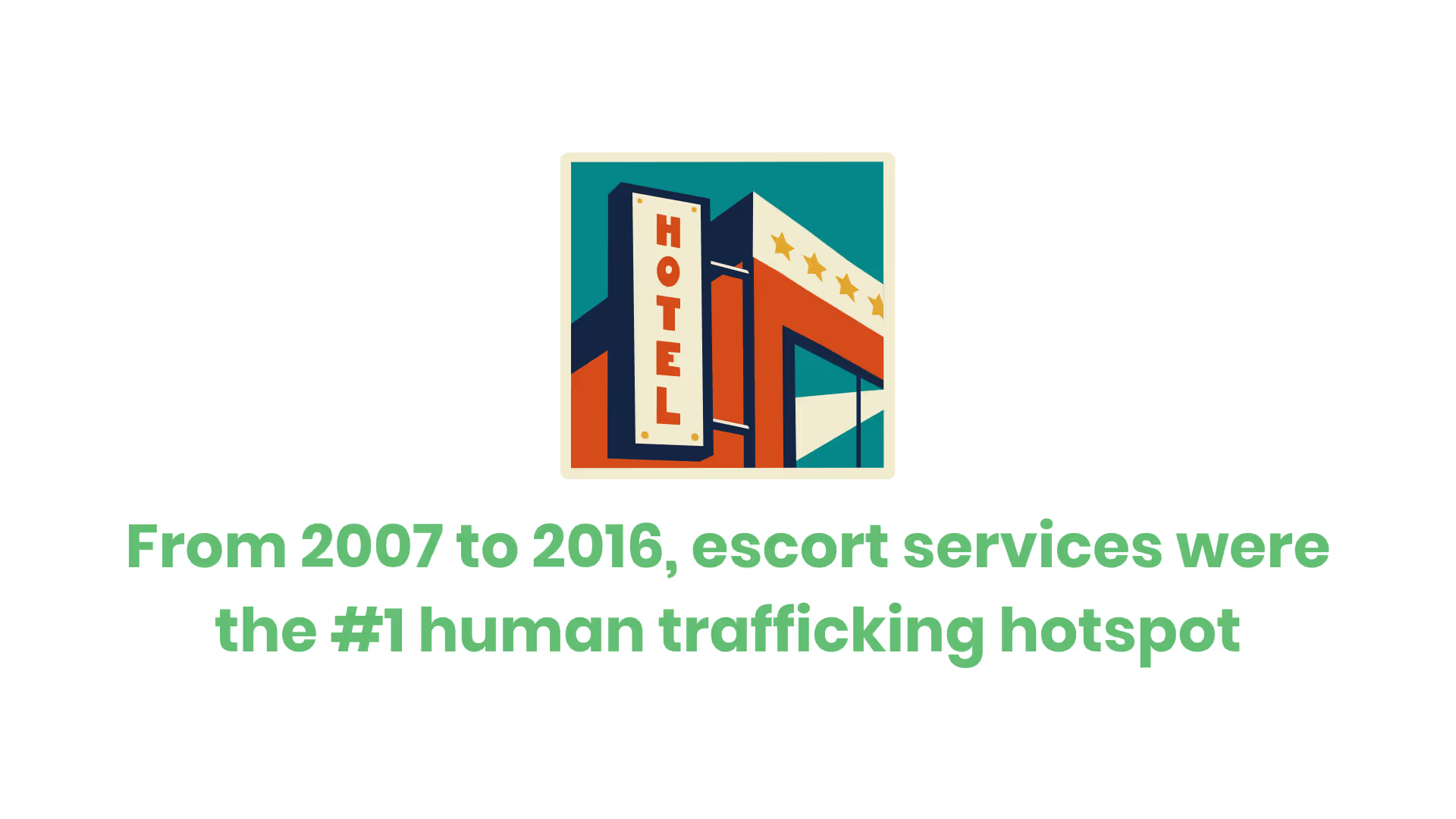
The operations are often referred to as an “out-call” because traffickers deliver victims to a buyer’s hotel room or residence for private parties. The operation changes to “in-call” when potential buyers cycle in and out of a hotel room where the trafficker is keeping the victim for extended stays.
What do victims of escort or delivery services look like?
The vast majority of victims in this type of trafficking are U.S. female citizens. About 95% of victims, or 4355 of them, are female. 2762 of them are adults and 1986 are minors. 46% of identified victims are U.S. citizens while 10% are foreign nationals. The rest are unknown.
Although most victims are female, men and boys do make up a small percentage. LGBTQ youth
are also vulnerable, although gender minorities are not trafficked in this way in large volumes.
Labor Trafficking
We don’t know if labor trafficking is as pervasive as sex trafficking in the United States. Unfortunately, it’s harder for the public to recognize labor exploitation and report tips to the hotlines.
The fact of the matter is that traffickers exploit victims in many industries, many of which are essential to Americans’ daily lives.
The Polaris Project identified 10,085 cases of labor trafficking from 2007 to 2016. In 2021 alone, the National Human Trafficking Hotline identified 1,066 cases, accounting for 10% of all cases identified that year.
Where did these cases take place? Let’s take a look at the industries, venues, and human trafficking hotspots for labor exploitation.
Begging Ring/Peddling Ring/Traveling Sales Crew
From 2007 to 2016, there were 575 identified cases of traveling sales crews and another 494 cases of peddling/begging rings.
Begging/peddling rings and traveling sales crews are slightly different but are similar enough to fall under the same category.
In traveling sales crews, potential victims travel in groups to various cities and/or states selling items door to door. Items sold include magazines, candy or cookies, cleaning products, coupons, and other items. These products are often fraudulent and the customers rarely receive the items they purchased.
These victims go door-to-door from morning until night and are unable to leave due to fraud, manipulation, and coercion. As such, traffickers find this type of labor trafficking financially rewarding and low-risk.
Victims of traveling sales crews are typically teenagers and young adults from marginalized and economically disadvantaged communities. Although most traffickers claim to “hire” those who are at least 18 years of age, they will traffick minors as young as 15. Unlike other types of trafficking, victims in traveling sales crews are overwhelmingly U.S. citizens.
Pedding and begging rings are a hotspot where traffickers expect potential victims to beg for “donations” or small items at outdoor locations.
Unlike traveling sales crews, these people don’t go door to door. Instead, they look like homeless individuals begging with signs on the sidewalk, hence begging rings, or peddlers with little booths with merchandise, hence peddling rings.
Agriculture/Farming/Animal Husbandry
Human trafficking in the farming and agricultural hotspot happens when a trafficker compels a victim to provide labor for a farming business. The victim engages in growing crops, cultivating soil, or rearing animals for their byproducts. Traffickers will exploit workers in areas like corn fields, orange orchards, and dairy farms.
Some crops like tobacco require more intensive labor to harvest, making them more susceptible to host victims of forced labor and exploitation. In fact, tobacco is the crop cited most often on Polaris-operated hotlines. It accounts for 10% of all agricultural labor trafficking cases.
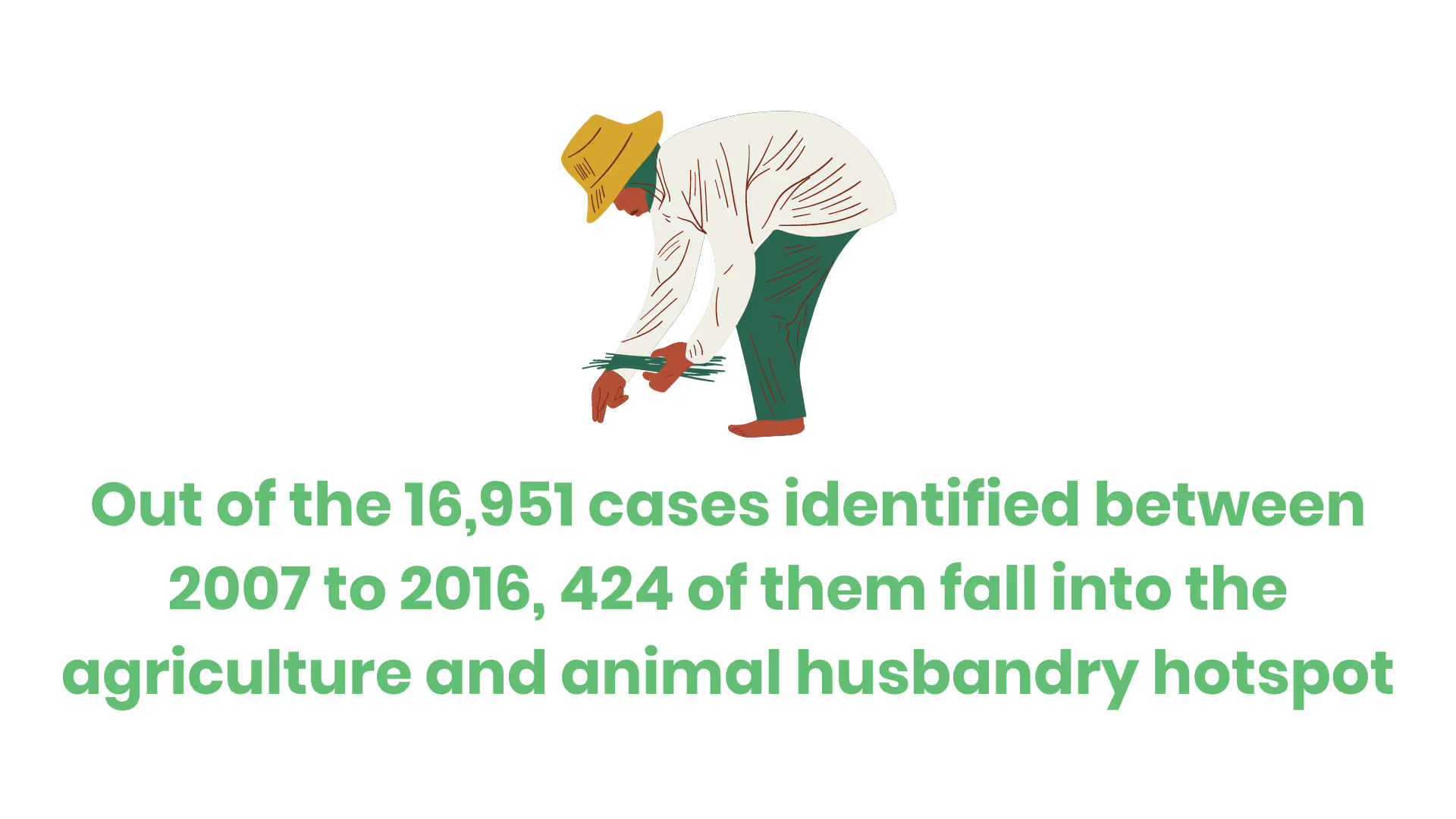
Other frequently mentioned forms of agricultural and animal husbandry trafficking include…
- Cattle/dairy
- Oranges
- Tomatoes
- Strawberries
How pervasive is this form of trafficking?
Out of the 16,951 cases identified between 2007 to 2016, 424 of them fall into the agriculture and animal husbandry hotspot. In 2021, there were 117 identified cases of this type of labor trafficking and another 3 cases that had both labor and sex trafficking elements.
According to cases reported to Polaris-operated chat lines, survivors are disproportionately Latino male migrant workers. Most are from Mexico and Central America in the U.S. on seasonal H-2A visas. Men from South Africa on the same type of visa rank a distant second.
Retail
Retail trafficking happens when a trafficker compels a victim to work at a commercial venue whose primary purpose is to sell merchandise. Common venues in the retail hotspot umbrella include…
- Gas stations
- Grocery stores
- Car dealerships
This means that you have likely met a human trafficking victim while they were actively trafficked and didn’t know it.
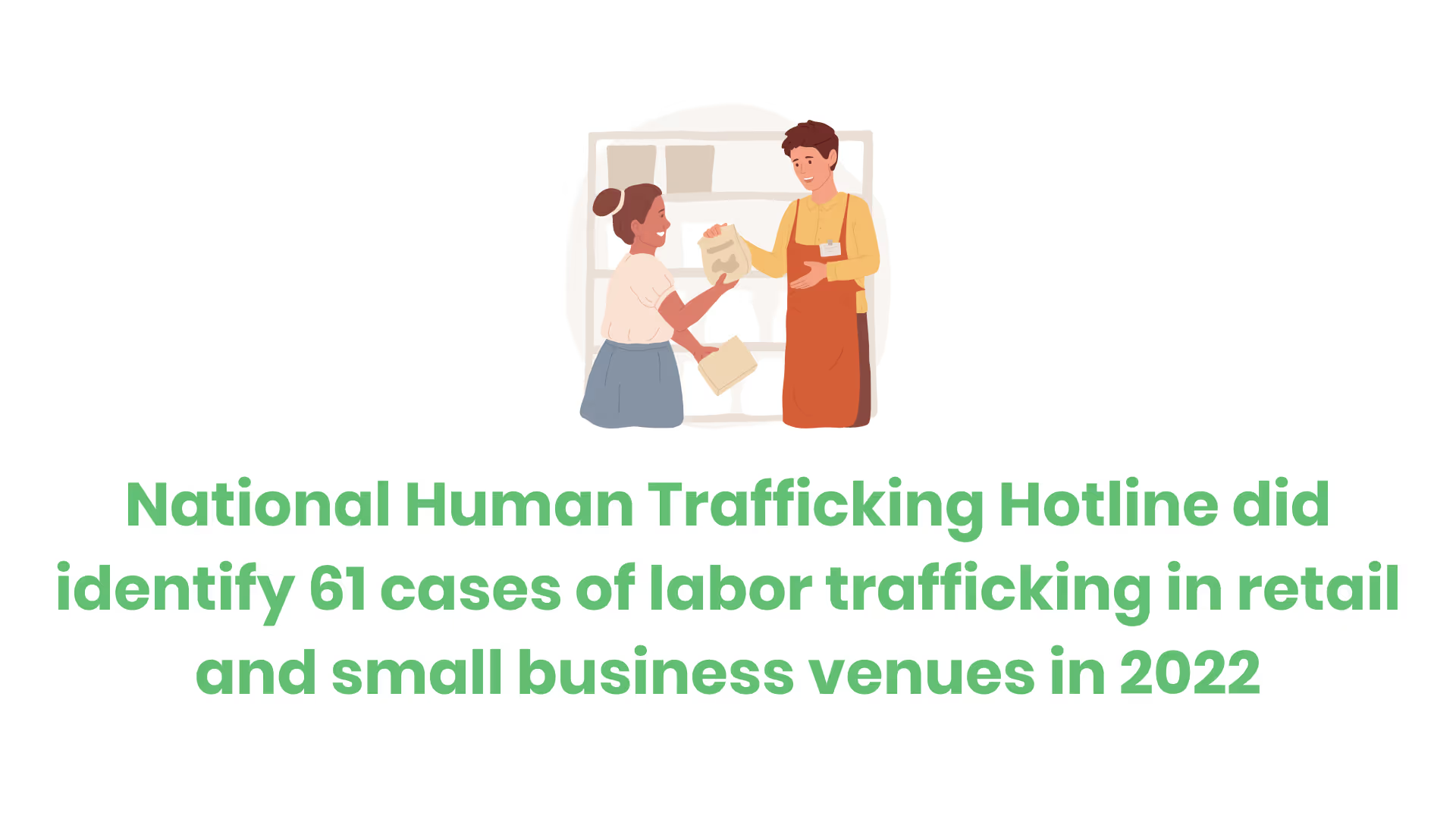
There isn’t much information about the retail hotspot because most people believe the “employee” to be legally employed and paid.
On the bright side, the National Human Trafficking Hotline did identify 61 cases of labor trafficking in retail and small business venues. They also identified an additional 7 cases that had both labor and sex trafficking elements.
Hopefully, these cases will help lead to more information about who the victims are and how they’re controlled by traffickers.
Housekeeping/Cleaning/Janitorial Service
In 2021, there were 16 identified cases of janitorial labor trafficking. There were an additional 5 cases with both labor and sex trafficking elements.
Janitorial trafficking happens when a trafficker compels a victim to work in janitorial or cleaning duties. They will work for a cleaning company, commercial properties, or public properties. This includes, but is not limited to, maid services and commercial janitors.
Unfortunately, the Polaris Project doesn’t have enough data to showcase victim demographics by percentage. They only identified 93 human trafficking cases and 344 labor trafficking cases between 2007 and 2016.
Therefore, we’re unable to inform you about what percentage of victims are male, female, adults, minors, citizens, and foreign nationals.
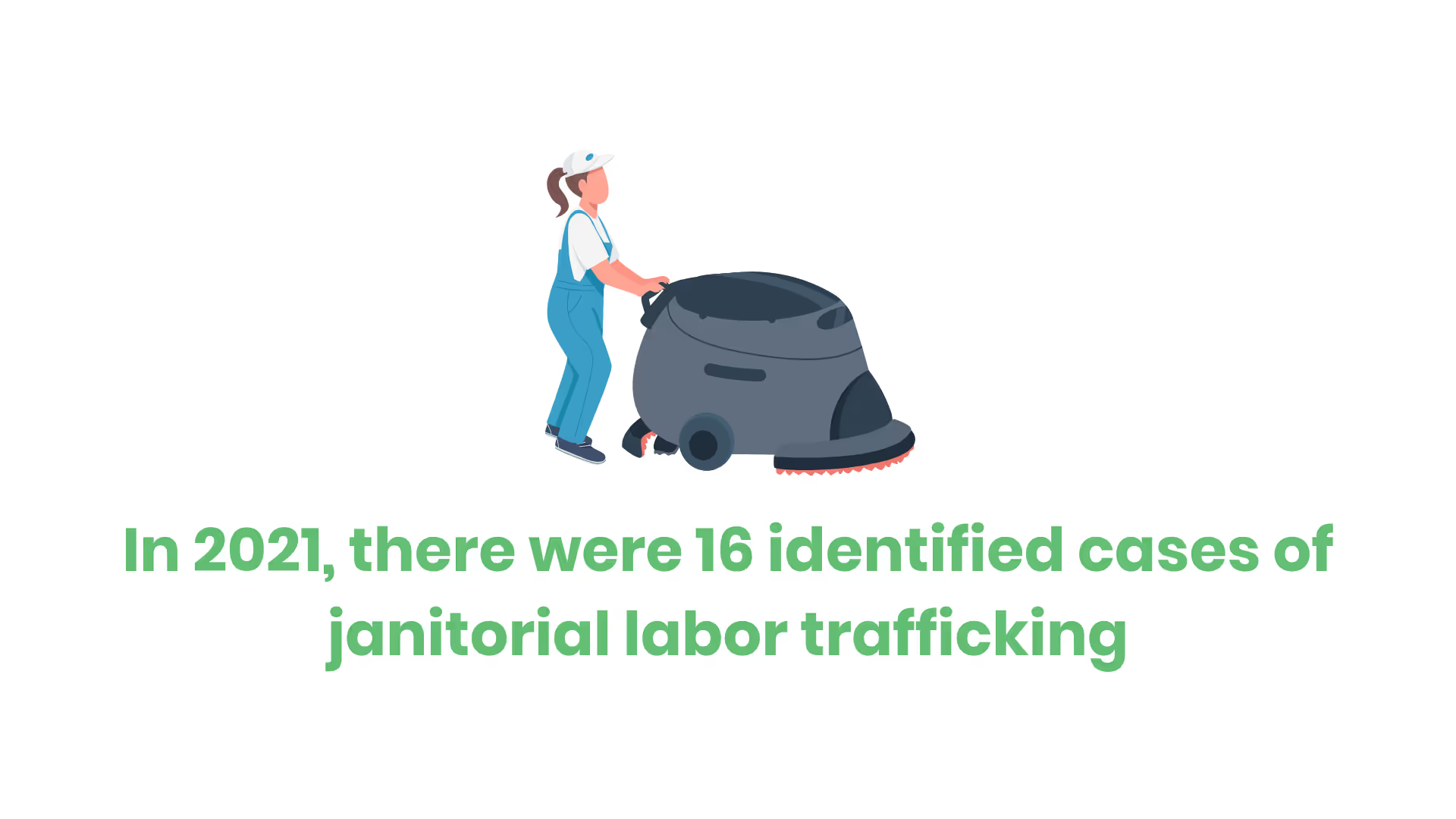
Though there’s limited data, there’s sufficient evidence that foreign national men, women, and unaccompanied children from Latin America are most susceptible to the janitorial human trafficking hotspot. Others are from the Philippines, the Caribbean, or are U.S. citizens.
We also know that common methods of control include…
- Withholding or confiscating wages
- Verbal abuse
- Long hours
- And threats of exposure to hazardous cleaning chemicals without proper protective equipment.
These situations officially become human trafficking when the victims must work off a debt, their passports are withheld, or they’re coerced with threats of homelessness or deportation if they refuse to work.
Healthcare
Labor trafficking in healthcare primarily happens in nursing homes and as health aids.
The problem with defining healthcare trafficking is that there’s often an overlap with domestic work. This is because some domestic caregivers have to provide medical services without proper certification. This is why we should also look at domestic work (found below) when looking at healthcare trafficking hot spots.
That said, some cases are exclusively healthcare-related with no overlap in the domestic work hotspot.
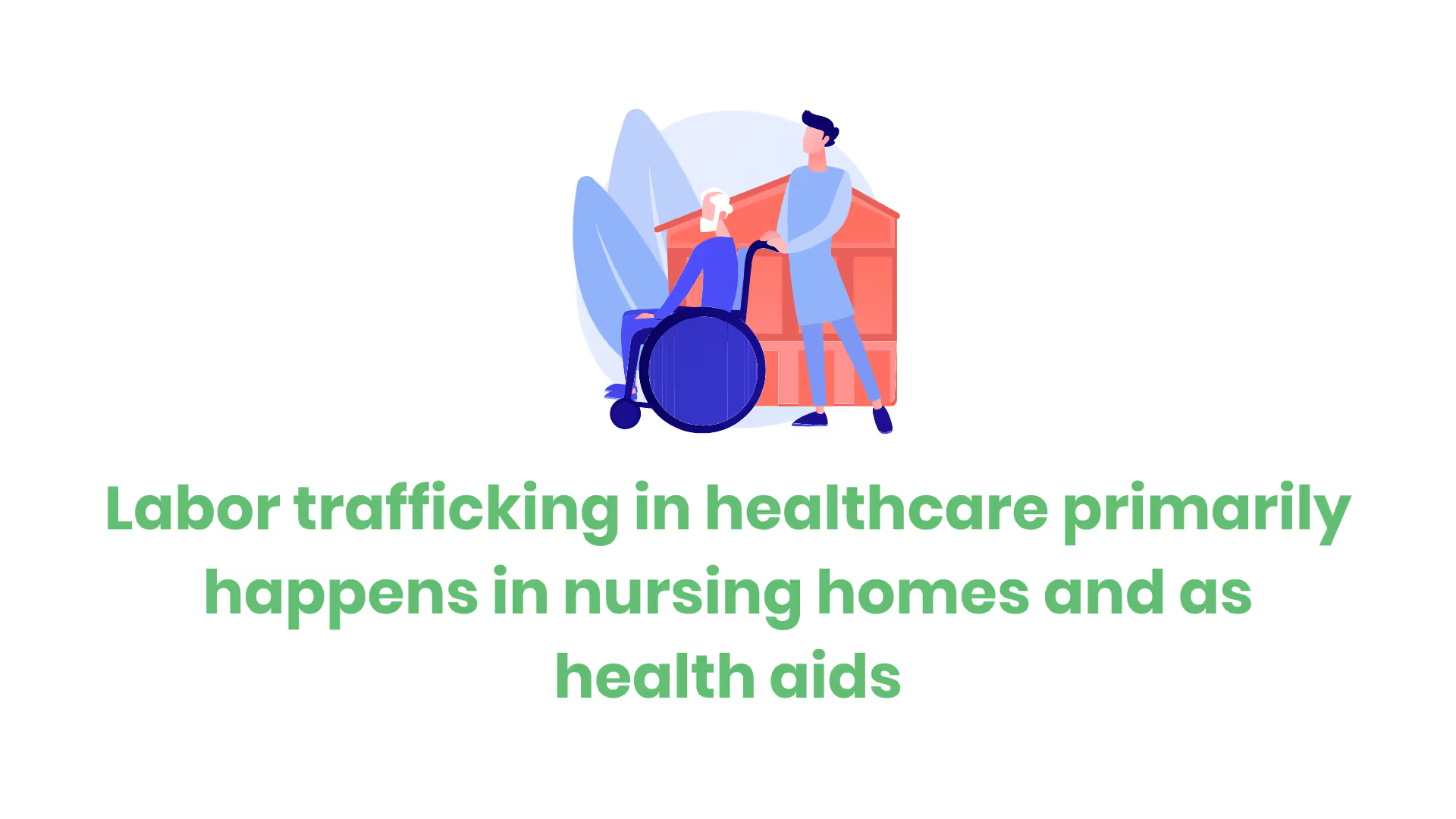
Victims of healthcare trafficking are typically migrant women from the Philippines. Immigrant women from West Africa and U.S. citizens are next in prevalence. If the victims are foreign nationals, they typically come to the U.S. legally with the use of registered nursing visas.
The Polaris Project identified 46 cases of healthcare trafficking between 2007 and 2016. They had another 59 cases of labor exploitation cases.
In 2021, the National Human Trafficking Hotline identified 16 cases of labor trafficking in that year alone.
Because the number of identified victims over the years is so small, it’s difficult to give proper statistics about this form of human trafficking.
Sex and Labor Trafficking
In 2021, the National Human Trafficking Hotline identified 400 cases of human trafficking that had elements of both commercial sex and labor exploitation. This accounts for 4% of all cases identified that year.
There are some industries and hotspots that are more prone to incorporate both labor and sex trafficking elements compared to just one or the other.
Let’s take a look at labor and sex trafficking hot spots.
Domestic Work
Out of 16,951 identified cases between 2007 and 2016, 1,190 of them happened in the domestic work hotspot. In 2021, there were 185 cases of labor trafficking and another 59 cases that had both labor and sex trafficking elements.
Human trafficking happening under the pretenses of domestic work will often have victims live within their “employer’s” household. The victims provide services such as cooking, cleaning, and caretaking for children or the elderly.
This form of human trafficking can also happen within the realm of intimate partner violence or forced marriage situations. In this way, the trafficker can maintain or exert power and control over the victim.
Speaking of power and control, labor trafficking victims in the realm of domestic work often work 12-18 hours a day for little to no pay. Some work as much as 24 hours, seven days a week. Trafficker use methods of control such as extreme isolation and confinement from the outside world, sexual harassment, high levels of monitoring, debt bondage, extreme wage theft, confiscation of critical documents such as passports, and restricted access to food and medical care.
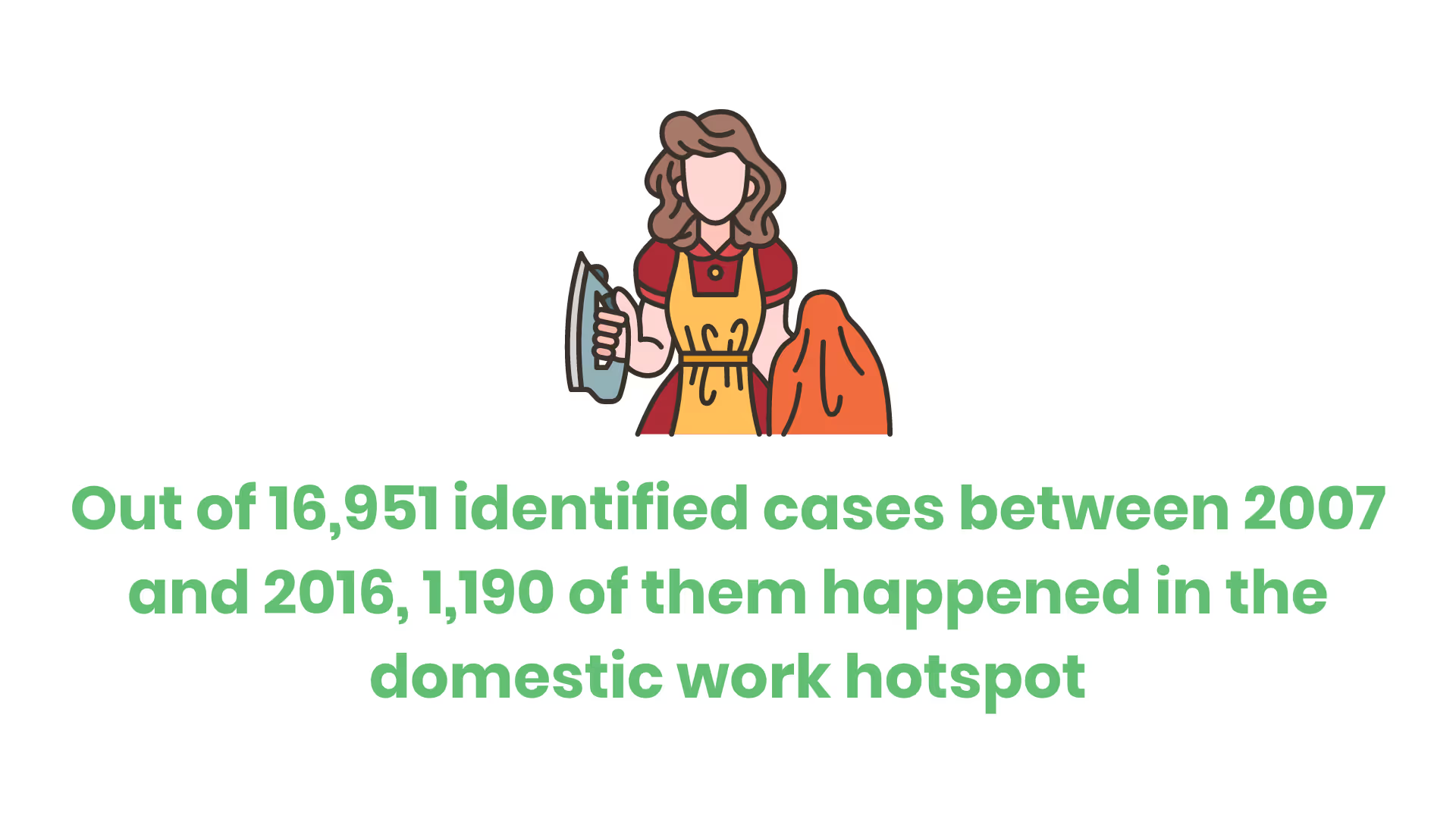
Traffickers often intentionally allow the victim’s visa to expire and use the victim’s legal status to create fear and distrust. This leads to even greater submission. Because of this, victims of domestic work can find themselves trafficked for years or decades.
What do these victims look like?
Data from the National Human Trafficking Hotline suggests that survivors are predominantly middle-aged or older-aged women from the Philippines. Many are also U.S. citizens or survivors from Latin America, India, and Sub-Saharan Africa. The data shows that survivors of domestic workers come from more than 105 countries.
Illicit Massage/Spa, Health, and Beauty Business
According to the Polaris Project, Illicit massage businesses and health and beauty parlors present themselves as legitimate spa service providers. But, in reality, they conceal both sex and labor trafficking. These venues trap people inside them to exploit the victims for commercial sex and labor exploitation.
The 2021 Federal Human Trafficking report defines it as when a trafficker solicits buyers of commercial sex at a business that offers or claims to offer legitimate spa services. These venues include legal massage parlors as well as illicit massage parlors that claim to offer legitimate spa services. However, the true purpose of these illicit parlors is to offer commercial sex to customers or offer services to people forced to work for little to no pay.

Although these businesses often appear to be single storefronts, the majority are part of larger networks. On average one or two three people own several businesses at a time. Research suggests that there are at least 7,000 illicit storefronts in the U.S.
In more concrete terms, out of 16,951 known cases from 2007 to 2016 with viable information, 2,949 of them were in the illicit massage/health and beauty hotspot. In 2021, 640 cases involved sex trafficking, labor trafficking, or both.
Most victims of illicit massage businesses are adult women in their mid-30s to late 50s. In fact, 2,195 victims, or 74% of them, are female while only 51, or 2% are male. Most victims are from China and South Korea. In more broad terms, 1243 victims, or 42% of them are foreign nationals. Only 97 victims, or 3%, are U.S. citizens in this particular hotspot.
In health and beauty venues specifically, victims are typically younger females in their mid-twenties and older from southeast Asia.
Hotel/Motel-Based and Hospitality
Both sex trafficking and labor trafficking happen at hotels, motels, and other hospitality establishments. From 2007 to 2016, out of 16,951 sex trafficking cases, 124 of them happened in hotels and hospitality. Another 510 labor trafficking cases happened in this particular hotspot.
In 2021, there were 579 hotel/motel-based human trafficking cases. There were an additional 3 cases that involved both labor and sex trafficking. At the same time, there were 36 labor trafficking cases in the general hospitality venue. Another 3 cases in hospitality hotspots had both labor and sex trafficking.
As mentioned before, victims are often forced to perform commercial sex acts for buyers while staying at a hotel or motel. However, in the world of labor trafficking, things are a little different. We can see this happen in the escort hotspot.

Victims of labor trafficking find themselves forced to work as front desk attendants, hotel housekeepers, bell staff, and more. The most common form of labor trafficking in hospitality is in the housekeeping department.
This means that traffickers in this hotspot can be hotel management or a labor recruiter/broker that subcontracts with the hotel to provide labor. If the trafficker is a contractor, the hotel may not be aware of the trafficking and abuse.
What do the victims look like?
Most victims, both men, and women are from Jamaica, the Philippines, and India. 69% of victims were female and 46% were male. The vast majority, 88%, of victims are adults while only 4% are minors.
Bars, Clubs, Strip Clubs, and Cantinas
When looking at new human trafficking cases in 2021, bar and club-based trafficking hosted 33 sex trafficking situations, 6 labor trafficking situations, and 9 with both identified by the National Human Trafficking Hotline. Strip clubs hosted an additional 47 cases of sex trafficking, 10 cases of labor trafficking, and 27 cases of both.
Between 2007 and 2016, there were 792 confirmed cases of human trafficking happening in bars, strip clubs, and cantinas.
According to the 2021 Federal Human Trafficking Report, human trafficking in a bar or club venue takes place when a trafficker solicits buyers of commercial sex at an establishment that serves alcohol or beverages as their primary business purpose.
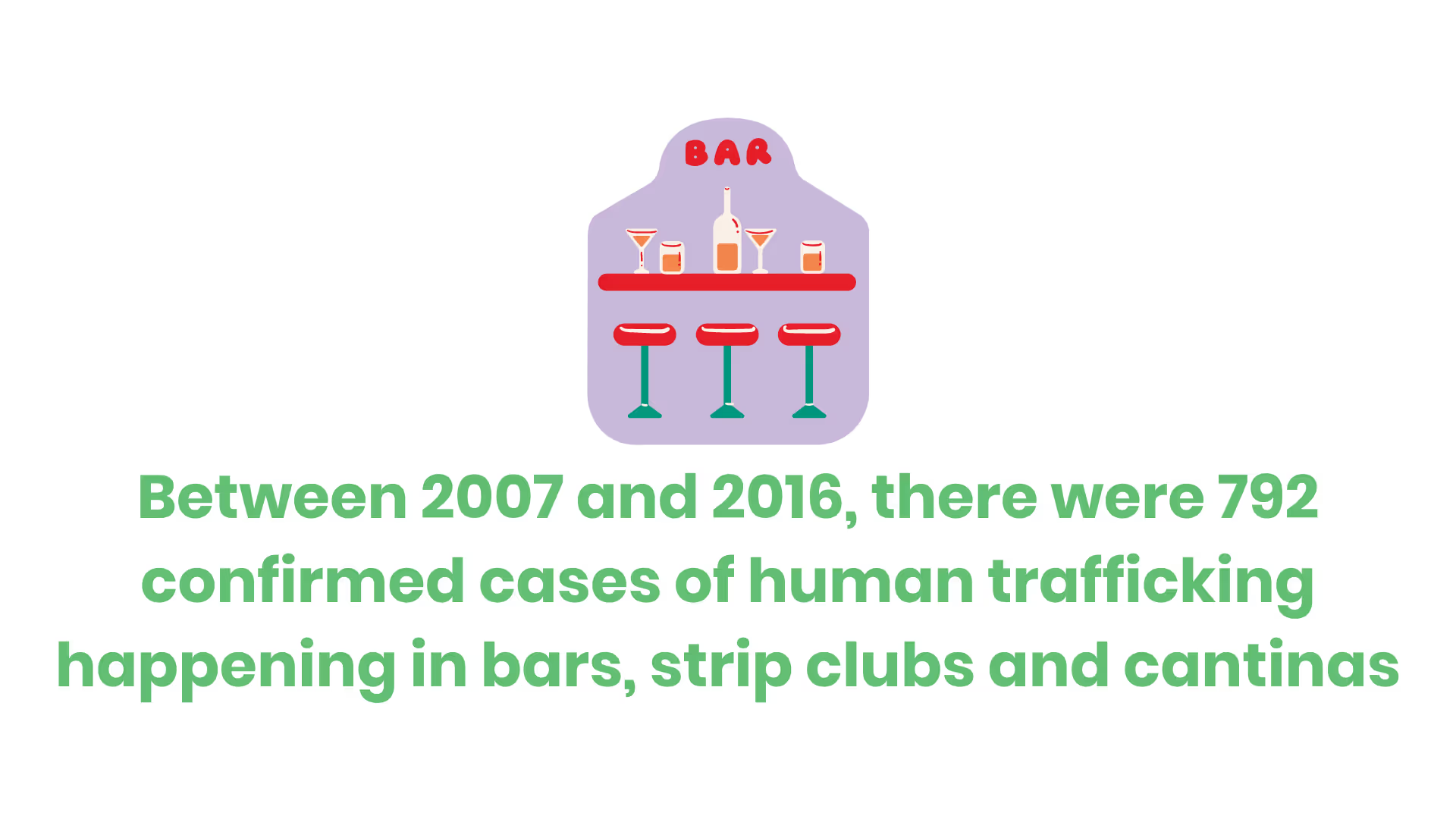
The Polaris Project takes the definition a step further. These venues are front as legitimate bars, restaurants, or clubs selling food and alcohol while exploiting victims behind the scenes. Victims have to flirt with customers to get them to pay for high-priced alcohol. The alcohol would then come with an explicit or implicit agreement for commercial sex acts.
In other words, human trafficking in bars and clubs often involves both labor trafficking and sex trafficking.
Sometimes the venues are entirely run by organized human trafficking networks. Other times, traffickers will have agreements with the business owners that allow the traffickers to operate out of the venue in exchange for a portion of the criminal profits.
Victims trafficked through bars, clubs, and cantinas are often girls from Mexico and Central America aged 14 to 29. Traffickers control their victims through extreme physical violence. They behead women and girls into submission, sexually assault them, and threaten them with weapons and death to their families if the victim does not comply. Traffickers will also trap their victims with insurmountable debts.
Construction
Trafficking in the construction hotspot happens when a trafficker compels a victim to provide labor or both labor and commercial sex at a commercial construction business. The labor services focus on the process of building or repairing infrastructure, facilities, or residences.
To be more specific, victims of construction trafficking are usually forced to work within small contracting businesses completing tasks such as…
- Roofing
- Carpentry
- Welding
- Electrical work
- Masonry
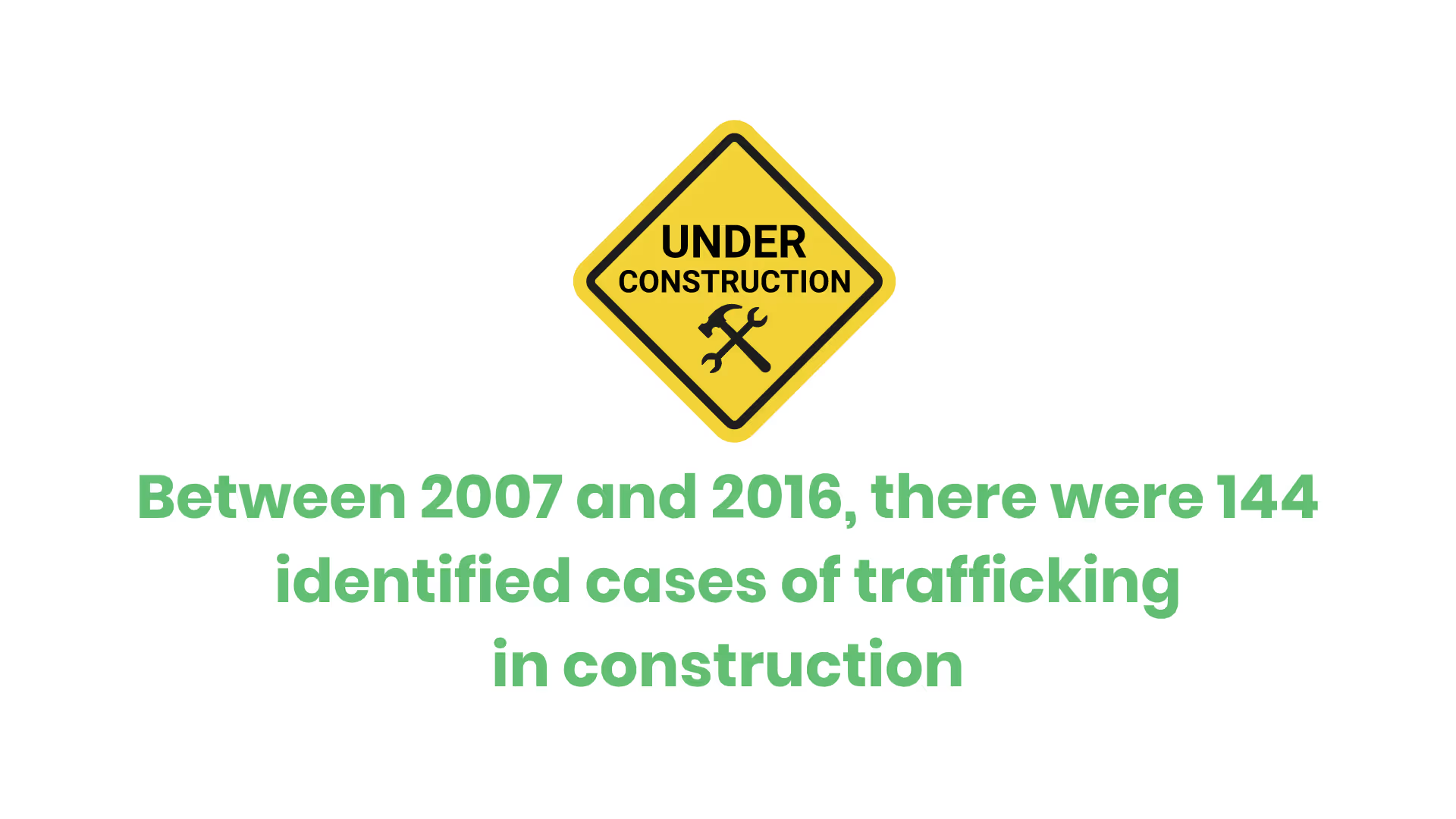
This happens on both large commercial construction sites and in private homes. Employers will misclassify workers as independent contractors, thus limiting the individual’s access to worker protections and benefits.
This form of trafficking is becoming more pervasive over time. Between 2007 and 2016, there were 144 identified cases of trafficking in this particular hotspot. In 2021 alone, there were 65 identified cases of labor trafficking and another 7 cases with both sex and labor trafficking components.
What do victims look like in construction venues?
Due to the nature of this trafficking hotspot, the majority of victims are males from Mexico and the Northern Triangle. This includes El Salvador, Honduras, and Guatemala. Most are either undocumented or have H-2B visas. As such, the majority of victims are foreign nationals because they are more easily manipulated and controlled through the use of threats.
This said, 15% of victims are U.S. citizens. While you can’t threaten these people with deportation, traffickers use other methods of control. U.S. citizen survivors must perform construction jobs under the control of fraudulent and unethical…
- Religious organizations
- Residential programs
- Drug recovery programs
Individuals posing as landlords will exploit a victim’s homelessness, forcing them to work construction jobs on the down low.
Conclusion
At the end of the day, one of the biggest hotspots for human trafficking is hotels. 75% of human trafficking survivors reported coming into contact with hotels at some point during their trafficking experience.
Despite crossing paths with hotel staff, nearly all victims report that they never received assistance. Whether trafficking occurs in hotspots like pornography, remote interactive sexual acts, escort/delivery services, traveling sales crews, domestic work, or something else, hotel staff failed to intervene.
Hotel operators and employees are on the front lines in the battle against human trafficking. No matter what venue and industry the trafficking are in, hotel staff need to receive training about identifying human trafficking victims.
Etactics produced a scenario-based training course for hotel operators and law enforcement in conjunction with Bill Woolf’s expertise in the matter. This training is available through the Etactics Learning Management system, K2 Akademy.
Resources
Emphasize your product's unique features or benefits to differentiate it from competitors
In nec dictum adipiscing pharetra enim etiam scelerisque dolor purus ipsum egestas cursus vulputate arcu egestas ut eu sed mollis consectetur mattis pharetra curabitur et maecenas in mattis fames consectetur ipsum quis risus mauris aliquam ornare nisl purus at ipsum nulla accumsan consectetur vestibulum suspendisse aliquam condimentum scelerisque lacinia pellentesque vestibulum condimentum turpis ligula pharetra dictum sapien facilisis sapien at sagittis et cursus congue.
- Pharetra curabitur et maecenas in mattis fames consectetur ipsum quis risus.
- Justo urna nisi auctor consequat consectetur dolor lectus blandit.
- Eget egestas volutpat lacinia vestibulum vitae mattis hendrerit.
- Ornare elit odio tellus orci bibendum dictum id sem congue enim amet diam.
Incorporate statistics or specific numbers to highlight the effectiveness or popularity of your offering
Convallis pellentesque ullamcorper sapien sed tristique fermentum proin amet quam tincidunt feugiat vitae neque quisque odio ut pellentesque ac mauris eget lectus. Pretium arcu turpis lacus sapien sit at eu sapien duis magna nunc nibh nam non ut nibh ultrices ultrices elementum egestas enim nisl sed cursus pellentesque sit dignissim enim euismod sit et convallis sed pelis viverra quam at nisl sit pharetra enim nisl nec vestibulum posuere in volutpat sed blandit neque risus.

Use time-sensitive language to encourage immediate action, such as "Limited Time Offer
Feugiat vitae neque quisque odio ut pellentesque ac mauris eget lectus. Pretium arcu turpis lacus sapien sit at eu sapien duis magna nunc nibh nam non ut nibh ultrices ultrices elementum egestas enim nisl sed cursus pellentesque sit dignissim enim euismod sit et convallis sed pelis viverra quam at nisl sit pharetra enim nisl nec vestibulum posuere in volutpat sed blandit neque risus.
- Pharetra curabitur et maecenas in mattis fames consectetur ipsum quis risus.
- Justo urna nisi auctor consequat consectetur dolor lectus blandit.
- Eget egestas volutpat lacinia vestibulum vitae mattis hendrerit.
- Ornare elit odio tellus orci bibendum dictum id sem congue enim amet diam.
Address customer pain points directly by showing how your product solves their problems
Feugiat vitae neque quisque odio ut pellentesque ac mauris eget lectus. Pretium arcu turpis lacus sapien sit at eu sapien duis magna nunc nibh nam non ut nibh ultrices ultrices elementum egestas enim nisl sed cursus pellentesque sit dignissim enim euismod sit et convallis sed pelis viverra quam at nisl sit pharetra enim nisl nec vestibulum posuere in volutpat sed blandit neque risus.
Vel etiam vel amet aenean eget in habitasse nunc duis tellus sem turpis risus aliquam ac volutpat tellus eu faucibus ullamcorper.
Tailor titles to your ideal customer segment using phrases like "Designed for Busy Professionals
Sed pretium id nibh id sit felis vitae volutpat volutpat adipiscing at sodales neque lectus mi phasellus commodo at elit suspendisse ornare faucibus lectus purus viverra in nec aliquet commodo et sed sed nisi tempor mi pellentesque arcu viverra pretium duis enim vulputate dignissim etiam ultrices vitae neque urna proin nibh diam turpis augue lacus.




